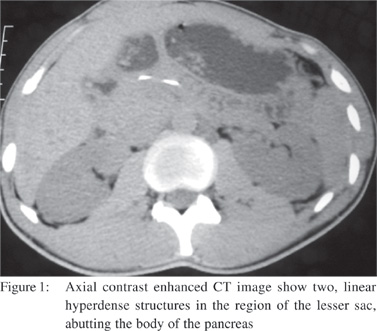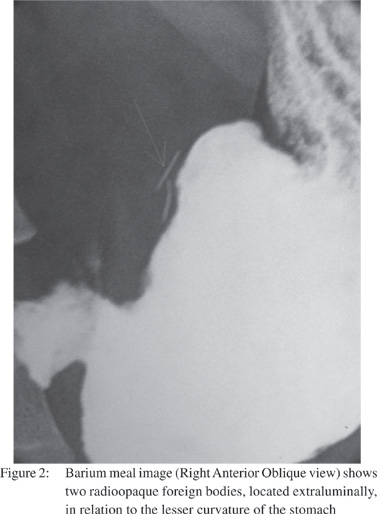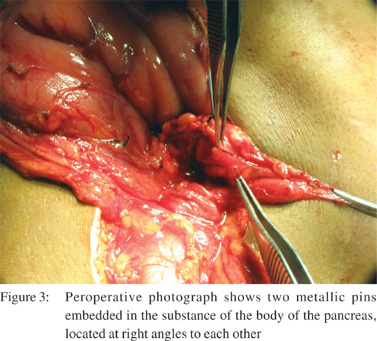48uep6bbphidvals|427
48uep6bbph|2000F98CTab_Articles|Fulltext
Introduction
Metallic intra-abdominal foreign bodies are an uncommon cause
of abdominal pain. They are often diagnosed serendipitously.
Foreign bodies have been retrieved from a myriad of locations.
However, intra-pancreatic location of such foreign bodies is
distinctly unusual. We report the successful retrieval of two
metallic pins which were found embedded in the pancreas.
Case Report
A 19 year old boy presented with persistent epigastric pain
radiating to the back, of three months duration. The patient denied history of recent jaundice, abdominal trauma and alcohol
ingestion, altered bowel habits or recent weight loss. Clinical examination was unremarkable. He was initially evaluated with
routine blood tests, serum amylase study and ultrasound study of the abdomen, which were normal. CECT abdomen
(Figure 1) revealed the presence of two linear, hyperdense
structures in the region of the lesser sac, abutting the body of
the pancreas. Barium meal study (Figure 2) clearly delineated
the extra-luminal location of the two metallic foreign bodies.
He was subsequently taken up for diagnostic laparoscopy.
Since the object could not be localised at laparoscopy, a mini laparotomy was done. Intraoperative fluoroscopy and‘mapping’ of the lesser sac and pancreas aided in the detection of the intra-pancreatic foreign bodies. Two thin (2 mm) metallic
pins, each 2 cm long, were found to be embedded in the body
of the pancreas at right angles to each other (Figure 3). They
could be retrieved with minimal trauma to the pancreatic tissue.
Postoperative period was uneventful and the patient was
discharged on the seventh postoperative day. The patient was
followed up at 3 months and he is doing fine.



Discussion
Although a variety of foreign bodies have been retrieved from
intra abdominal viscera, only one case of successful retrieval of intra-pancreatic foreign body has been reported till date.[1]
In the above mentioned case, the metallic foreign body was found embedded in the body of the pancreas as a result of
penetration from the level of D3. In our case, whether a similar path was the route adopted by the foreign body is a matter of
conjecture. Unusual locations of metallic foreign bodies following silent perforation of the viscera include the liver
and small bowel mesentery.[2] Intraoperative fluoroscopy and ‘mapping’ of the lesser sac and the pancreas with a non
toothed forceps greatly aided in the localisation. Other techniques used for intraoperative localisation of metallic
foreign bodies include electronic amplifier devices and magnetic probes.[3,4]
Conclusion
This case report highlights the unusual location of accidentally
ingested metallic foreign bodies and the techniques useful in their retrieval. A good history regarding the occupation of a
patient who presents with abdominal pain needs to be emphasised here. The patient was working as a technician for
air conditioning systems and confessed to biting off pieces of metallic pins and wire, during his job, when retrospectively
questioned regarding the same. He has been advised to be cautious while carrying on with his profession.
References
- Rasiqa I, Brebeanu G, Stãnescu S, Pascu A, Azamfirei I. Intrapancreatic foreign body. Rev Chir Oncol Radiol O R L
Oftalmol Stomatol Chir. 1977;26:461–2.
- Harjai MM, Gill M, Singh Y, Sharma A . Intra-abdominal needles:
an enigma (a report of two cases). Int Surg. 2000;85:130–2.
- Veselko M, Trobec R. Intraoperative localization of retained
metallic fragments in missile wounds. J Trauma.
2000;49:1052–8.
- Kandioler-Eckersberger D, Niederle B, Herbst F, Wenzl E. A
magnetic probe to retrieve broken metallic parts of instruments
during laparoscopic procedures. Surg Endosc. 2002;16:208–9.